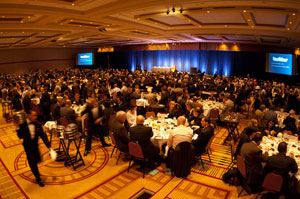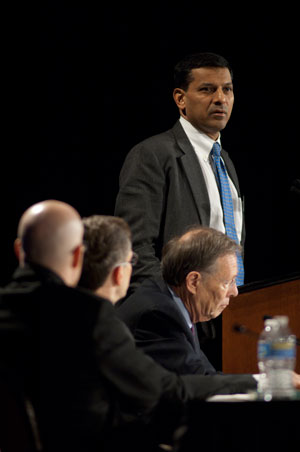Dollar signs
Chicago Booth economists predict lingering effects of the housing bubble and persistent unemployment will limit the expected recovery in 2011.
By Jeff Carroll
Photography by Matthew Gilson

Over lunch, some 1,000 attendees digested mixed information about the economic outlook.
Zipping through a PowerPoint presentation, Chicago Booth’s Erik Hurst stops and lingers on one telling slide. The line graph represents a housing-price bubble—but not the nationwide bubble that burst in the last decade, bringing housing prices and nearly the entire world economy down with it.
Rather, Hurst’s graph illustrates a similar occurrence in New York state in the 1980s, when housing prices ballooned until 1988, then plummeted sharply over the next several years. It took most of the next decade for prices in the state to return to preburst levels.
Hurst, the V. Duane Rath professor of economics and Neubauer family faculty fellow, used the data to explain why he anticipates a slow and painful recovery for the U.S. housing market—and the overall economy. He has studied micromarket bubbles to predict what lies ahead. All of the examples lead to one conclusion: slow recovery. In fact, said Hurst, “I can’t find one counterexample.”
Hurst and Chicago Booth’s Randall Kroszner, the Norman R. Bobins professor of economics, and Raghuram G. Rajan, the Eric J. Gleacher distinguished service professor of finance, shared their predictions for 2011. An audience of 1,000 attended the November 30 Business Forecast luncheon at the downtown Chicago Sheraton. Two other Chicago Booth forecast events were held in London and Singapore.
Economic recovery will be slow, Hurst says, because the massive misallocation of resources that the housing boom created cannot be quickly remedied. During the ten years after 1997, he said, 40 percent more housing was constructed in the United States than in any decade on record. Today 2.3 percent of single-family homes are vacant, an increase of more than 64 percent since 2005.
The housing oversupply, in turn, has contributed significantly to high unemployment. As the construction industry boomed, much of the American workforce shifted to housing-related industries, on both the construction and banking sides. Now, of 3 million open jobs in the United States, only 65,000 are in housing-related fields, Hurst said. Thus, many unemployed workers are qualified for jobs that are no longer available—jobs, he predicts, that won’t come back.
On a brighter note, many businesses have started to invest again and will continue to do so into 2011, said Kroszner, a member of the Federal Reserve Board from 2006 to ’09. In particular, investment in nonhuman resources, like software and other equipment, has picked up since the recession’s darkest days. “The basic production machinery of the economy is not broken,” Kroszner argued.
Yet hiring remains slow. Many recently created jobs are temporary as employers remain skittish about restocking their workforces to prerecession levels because of uncertainty about tax rates and health-care costs. Since the March 2010 passage of the Patient Protection and Affordable Care Act, policy analysts on both the left and right have been double-checking the calculations of the Congressional Budget Office to gauge the legislation’s long-term effects on business costs.

Rajan praised the Fed but cautioned against providing additional stimulus.
Kroszner did not anticipate that an expected round of quantitative easing by the U.S. Federal Reserve, a method of pumping an estimated $600 billion into the economy mostly through bond purchases, would affect markets in 2011, because they have already adjusted to that probability. Federal Reserve chair Ben Bernanke’s biggest challenge in the coming year, he said, will be to quell concerns about deflation, lest spending grind to a halt as consumers wait for lower prices.
Bernanke and the Fed should “be put on a pedestal,” Rajan said, for the job they did during precarious times in late 2008 and early 2009 when catastrophe was constantly one false move away. Yet he warned against trying to stimulate the current slow recovery because of the unique characteristics of this recession and recovery, in particular the housing market’s role in the crash along with the credit crunch that led to the 2008 Troubled Assets Relief Program government “bailout” of big banks.
“This crisis offers us an opportunity to think about whether the growth that we had earlier was sustainable and whether, in fact, we should spend our time not thinking about stimulating our way back to the earlier ways of growth ... but really whether we should be thinking about structuring new ways of growth,” said Rajan, the author of Fault Lines: How Hidden Fractures Still Threaten the World Economy (Princeton University Press, 2010). “The notion that in some way we need the Fed to stimulate the economy back to action, and that it has no side effects, I think, is very worrisome.”
Regardless of what methods the government employs to spur the recovery along, all three professors seemed to agree that recovery will set a plodding pace that probably requires yet more patience from the American public.
Return to top
